◆Main House for residence◆
The present main house of Honjin has a structure that was rebuilt just after it was broken out by a big fire 1861. It was defferent from the structure before then in some ways.
Its site scale is about a half of that in Edo period. It reached to the part 15 meters southmore including the prefectural road 178. The guest hall was standing there.
Therfore two big buildings were standing side by side in such a wide site along Kaido.
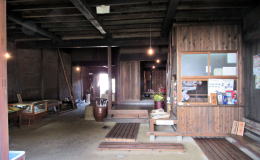
▲Inside of a side door is a kitchen, partly a earth floor.
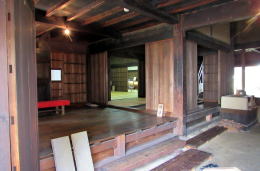
▲A view of them from the back door
The host family and servants lived in the main house. They got ready the services for the guests staying and having meals there.
The structure of the house is very large and grace, as the highest class officers of the town lived in it at the same time it was a office for administration.
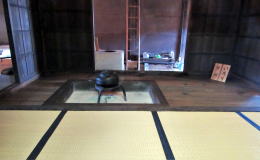
▲Irori hearth in a kicthen
◆Stage-Town Officers◆
The roles of the stage-town officers are explained in the articles aboutHistory of Kisoji and Kaido and Stage-town.
Here shall we think how they worked about the administration and the economic management of the stage-town under the condition of Wada town.
Most stage-town was in the domain of Shogunate government or the Tokugawas' clan. As the control and administration over them was very complicated, the daily management was broken down to the local government or agency. For example in Kiso area was allocated and leaved to the Owari Tokugawas clan.
Wada town was ruled by the magistrate nominated by Shogun. But on the daily administration, the families of Honjin, Toiya, Wkihinjin and their supporters took charge. At same time they managed services for Kaido traffic-transportion.
The main duties of them were managing to supply services for the official inn and to operate for relaying transportion along Kaido road. The taxes they had to pay was to take charge of those services. Because managing them was rather expensive, the duties were assigned to the rich and powerful families in the town.
Therefore they made people in the town obey the rule of Shogunate government to support Kaido system, appealing people's demand to it.
◆Role of Honjin◆
By the way Honjin was repidly rebuilt just after its destructionby fire to welcome the princess Kazunomiya travelling to Edo for wedding. Then the main house and the guest hall become larger and more graceful than before. On Nakasendo no other Honjin was more grand then them.
The guest hall, sometimes called a palace, was the place for the lords or the nobles from Kyoto or the high class officers of the government to stay.
Each lord was travelling to or from Edo together with his vassals, the number of which was ruled owing to his rank and fief-scale. They formated a marching parade. The spearmen marched at a top of the parade and the bow- or gun-troops, furthermore the retainers carrying clothes and goods of the lord.
The stage-towns had to receive them all for stay or rest. The lord staied at Honjin hall, high rank vassals at Wakihonjin and other retainers at ordinary inns.
However the great clans for example the Owaris or the Maedas of Kaga clan the number os the vassals and retainers is over 3,000 to 5,000 or more. They are far beyond the capacity of Wada town. In such a case they were devided into some parts to stay in other towns or villages next to or neighboring, for example Shimowada, Nagakubo and Furumachi or so.
Honjin had a stable for the horses of the lord and a warehouse for vassals' weapons ― spears, guns and bows ―.
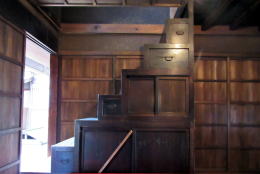
▲Stirs consist of box drawers
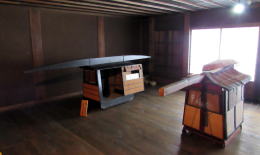
▲Four kinds palanquins desplayed on the second floor. One is for lords and another for ordinary people.
|
